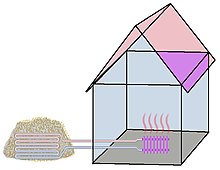Biomeiler
A biomeiler (also known as compost heating ) is a system for the energetic use of biomass , more precisely for the generation of heat for heating purposes . For this purpose, mostly shredded wood is piled up in a pile and a water hose is passed through. Through microbiological degradation processes, heat is released over a period of 18 to 24 months, with which warm water can be generated, which can be used for heating. With a sufficient supply of oxygen , the biomass used is broken down through aerobic decomposition . In contrast to biogas production, there is no putrefaction in a correctly constructed biomiler . The activity of the microorganisms can be regulated with water. After the useful life, valuable compost has been created from the wood waste .
The method was developed by the French forester Jean Pain in the 1970s. Today, bio-fuelers are used as small systems for local heating supply. Local waste (forest waste, shrub cuttings, wood chips that have become damp - inferior for burning - wood chips , dung heaps ) can be used for energy.
In the case of supply pipes and hoses and lines from and to circulating water pumps, the diameter should be selected as large as possible. The volume flow is dependent on the fourth power of the radius (due to the Hagen-Poiseuille law ). For example, reducing the pipe diameter by half would increase the flow resistance 16 times or increasing the pipe diameter by three times (one and a half inches instead of half an inch) the volume flow by 81 times. Increasing the pipe diameter can therefore increase the pumping capacity of a pump (with the effect of a greater pumping height or more flow), which means that weaker pumps can be selected, which significantly reduces energy costs.
Individual evidence
- ↑ Christian Schembritzki, Falk Pißler, Tina Bernecker: rounder Biomeiler. In: Oya . No. 11, 2011. (oya-online.de)
literature
- Ida and Jean Pain: The Jean Pain Methods or "Another Garden". 1981. (online at web.archive.org )
